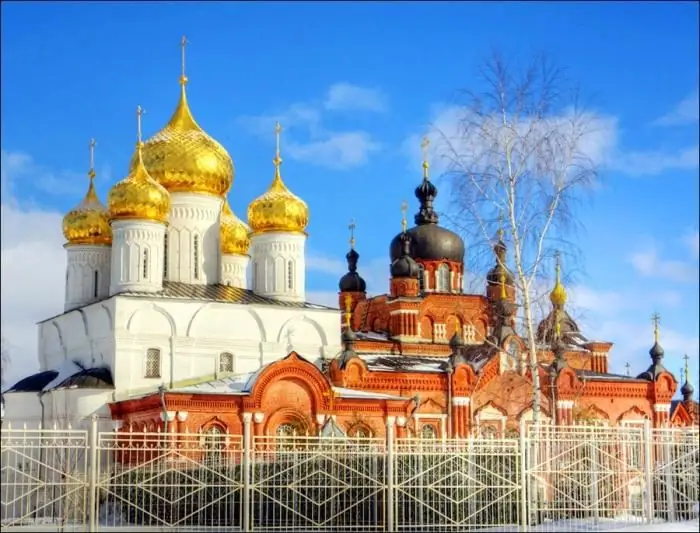- Author Harold Hamphrey [email protected].
- Public 2023-12-17 10:06.
- Last modified 2025-01-24 11:10.
The oldest and, perhaps, the most diverse Petrograd side of St. Petersburg is the real center of the city. Although the left bank of the Neva is officially considered the center, today life is more in full swing on Petrogradka. There are many attractions, museums, parks, unusual corners and monuments, but the main thing that the area is proud of is one of the best Art Nouveau buildings in Europe.

The emergence of a settlement
The Petrograd side geographically unites several islands in the Neva delta. The very first settlement appears on Hare Island, where the Peter and Paul Fortress was founded in 1703. A little later, the first buildings appeared on Petrogradsky (then Fomin) Island. The first residence of Peter the Great is also being built here, around which the center of the future capital is being formed. The buildings of the Senate, customs, the mint, diplomatic missions of foreign countries are being built here,wooden Trinity Cathedral.
Gradually, the city on the Petrograd side is growing, the Academy and the University are being built. The Aptekarsky Island is also settling in. But the development on both islands is chaotic, reminiscent of medieval cities. In 1721, on Petrogradsky Island, Peter the Great takes the title of Emperor of Russia. However, since 1717, Peter transferred the city center to Vasilyevsky Island, where he began to build a planned city, with straight streets and squares. Petrogradka is gradually losing its significance, several fires and the removal of buildings by the population for firewood lead to the fact that the area is becoming less and less presentable. In the middle of the 18th century, two main avenues were laid on the site of the old buildings, thereby setting a rectangular grid for the new building. However, some of the old, twisted streets have survived. With the formation of the city center on the left bank, the Petrograd side falls into disrepair, becomes the outskirts of the city.

Flourishing of the Petrograd Side
At the end of the 19th century, the Petrograd side is experiencing a rebirth. Her lands were looked after by architects who build houses for the bourgeoisie, bohemians and aristocracy. This area was more environmentally attractive, it was possible to build new houses here with the desired scope. All this led to the fact that Petrogradka quickly became the most fashionable place to live. But it is built up with spectacular houses in the Art Nouveau style, which was progressive at that time. Numerous tenement houses, shops and restaurants are also being built here. The area becomesrespectable, with lots of greenery. Since that time, the Petrograd side has not lost its significance as the most important district of St. Petersburg.

Modern structure of the district
Eighteen administrative districts form St. Petersburg, the Petrograd side is one of the most interesting historical parts of the city. Today, several administrative units are included in the Petrogradsky district, including the historically established part, called the Petersburg side, and then the Petrograd side. It is located on four islands: Petrogradsky, the largest and most populated, Aptekarsky, Hare and Petrovsky.
Hare Island
The Petrograd side is primarily famous for the Peter and Paul Fortress, which was built on Hare Island. It is located in the widest part of the Neva, which is very good from a strategic point of view. This was the reason for the choice of a place for the construction of the fortress. Initially, wooden defensive fortifications were erected here, the mint moved here from Moscow. But the tree quickly began to deteriorate, and Peter decided to build a stone fortress.
Today, on the island, in addition to the fortress, you can see a funny monument to the Hare, which once gave the name to this territory. There is also a beautiful park, several interesting museums and a delightful promenade.

Peter and Paul Fortress
The Petrograd side is strongly associated with the first fortificationscities. The Peter and Paul Fortress with its contours almost completely repeats the shape of the island. The French engineer de Guerin created the blueprints for the first bastions. In the 30s and 40s of the 18th century, the embankments were dressed in stone according to the Trezzini project, at the same time the tradition appeared to celebrate noon with a cannon shot. In 1713-1733, D. Trezzini erected the Peter and Paul Cathedral on the island, the spire of which today is one of the main symbols of St. Petersburg. The cathedral was made in the early baroque style, new for Russia, and it will become a model for the construction of many cathedrals throughout the country. In addition to the cathedral in the fortress, the commandant's house, the monument to Peter I by M. Shemyakin, Peter's boat house are of interest.
Today in the Peter and Paul Fortress you can walk along the walls of the bastion, look at the prison, climb the bell tower and look at the city from a height, go to the Peter and Paul Cathedral to view the imperial tombs.

History of Petrograd Island
The original names of the island: Berezovy, Fomin, Troitsky, later Petersburg and finally Petrogradsky. Fomin Island began to be built up in 1703, when Peter the Great settled here to supervise the construction of the Peter and Paul Fortress. To accommodate it, a simple wooden hut was built, which today is called Peter's house.
The main thoroughfares of the island - Bolshoy, Kamennoostrovsky and Maly prospect of the Petrograd side - create the geometric layout of the area, which began to take shape in the late 19th - early 20th century. Islandrich in attractions: a zoo, a planetarium, the famous cruiser Aurora is moored here.
The main development of the island falls on the turn of the 19th-20th centuries, at this time the main attractions appear that today make up its glory: the Kshesinskaya mansion, Witte, the spectacular cathedral mosque, the summer palace of Peter the Great, the Prince Vladimir Cathedral, built by A. Rinaldi and I. Stasov. The Bolshaya Petrogradskaya Storona is one of the brightest parts of the city, it is based on two main avenues.
The first embankment of St. Petersburg, bearing the name of Peter, also contained many interesting buildings, including the Nakhimov School, built by Dmitriev in 1910 in the style of Peter the Great Baroque. Nearby, on X-ray Street, there is one of the best buildings in St. Petersburg in the Art Nouveau style - Chaev's house. When descending to the river, you should also pay attention to the unusual figures of Chinese Shih Tsza lions.

Kamennoostrovsky prospect: history and sights
Today, the avenue is a busy thoroughfare lined with magnificent buildings. And it all began in 1712, when the first miles of this street were laid. Gradually, the avenue lengthens, expands and becomes an important transport artery of the city. The starting point of the avenue can be considered Trinity Square, where one of the first churches in the city once stood. Today, the new Trinity Chapel stands here. The avenue is surrounded by many gardens and parks, which create such a pleasant atmosphere of this part.islands.
The highway is lined with magnificent houses from the early 20th century. The most striking buildings include the so-called "House with Towers", built by the architect A. Belogrud in the retrospective style. Another gem is the House of Ida Lidval. It was erected at the turn of the 19th and 20th centuries by the architect F. Lidval for his mother. The building is a masterpiece in Art Nouveau style. The mansion of S. Witte in the style of mature eclecticism is of historical value. However, almost every house on the avenue has a certain architectural value, you can look at them for hours.

Big Avenue: buildings and sights
Big Prospect of the Petrograd side is also rich in wonderful buildings. These include Tuchkov buyan Rinaldi, the chapel of Alexander Nevsky, Putilova's tenement house, or "House with Owls" - an excellent example of northern Art Nouveau. Almost every house on the avenue has architectural value. Bolshoy Prospekt of the Petrogradskaya Storona is a real architectural encyclopedia of the early 20th century, all important trends and many famous architects are represented here.

Apothecary Island
The Petrograd side of St. Petersburg was settled by Peter the Great, he gave a small island for a pharmaceutical garden (hence the name), where medicinal plants were grown. A relatively small island today, for the most part given over to the Botanical Garden, where you can see a lot of interesting flora. The island is also interesting in that with other partscity land it is connected by seven bridges. The island houses two major universities, several research institutes, the St. Petersburg Television Center, the F. Chaliapin House Museum, the Museum of the History of Photography, the Church of the Transfiguration of the Lord, built by the famous architect K. Ton in the Russian-Byzantine style.
Bridges of Petrogradka
The Petrograd side of St. Petersburg is connected to other parts of the city by eight bridges: Tuchkov, Birzhev, Yelagin, Ushakovsky, Kantemirovsky, Grenadier, Sampsonievsky and Troitsky.
There are also several "internal" bridges: Aptekarsky, Silin, Karpovsky, Barochny, numerous park bridges. Walking across bridges and exploring their architectural and design features can be a fun way to spend your free time.






